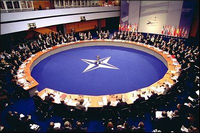The past year was an eventful one for NATO, but despite the success of the alliance's intervention in Libya, persistent problems will continue to affect trans-Atlantic defense relations in the new year. The United States will need to redouble its efforts in 2012 to make progress, with the NATO Summit in Chicago this May providing an opportunity for high-level attention to the issue.
The alliance's main problem is that European member states spend too little on defense. On average, their military expenditures have fallen almost 2 percent annually during the past decade, despite the continuing operations in Afghanistan. In the aggregate, since the end of the Cold War, defense spending by the European NATO countries has fallen by almost 20 percent, while their combined GDP has risen by around 55 percent.
This inverse relationship between military spending and GDP growth portends poorly for the future, especially since the United States' massive $1.34 trillion budget deficit could soon force some reductions in U.S. defense spending. Even the largest European NATO members have passed austerity measures that cut defense budgets, thereby decreasing future capabilities. Collectively, Europe risks becoming increasingly irrelevant as a global security actor, unable to promote stability even in nearby regions.

